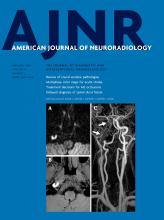Abstract
BACKGROUND AND PURPOSE: The newly developed ultra-high-resolution CT is equipped with a 0.25-mm detector, which has one-half the conventional section thickness, one-half the in-plane detector element width, and one-half the reconstructed pixel width compared with conventional-detector CT. Thus, the ultra-high-resolution CT scanner should provide better image quality for microvasculature than the conventional-detector CT scanners. This study aimed to determine whether ultra-high-resolution CT produces superior-quality images of the lenticulostriate arteries compared with conventional-detector CT.
MATERIALS AND METHODS: From February 2017 to June 2017, thirteen patients with aneurysms (4 men, 9 women; mean age, 61.2 years) who underwent head CTA with both ultra-high-resolution CT and conventional-detector CT were enrolled. Two board-certified radiologists determined the number of all lenticulostriate arteries on the CTA coronal images of the MCA M1 segment reconstructed from 512 matrixes on conventional-detector CT and 1024 matrixes on ultra-high-resolution CT.
RESULTS: There were statistically more lenticulostriate arteries identified on ultra-high-resolution CT (average, 2.85 ± 0.83; 95% CI, 2.509–3.183) than on conventional-detector CT (average, 2.17 ± 0.76; 95% CI, 1.866–2.480) (P = .009) in 16 of the total 26 MCA M1 segments.
CONCLUSIONS: Improvements in lenticulostriate artery visualization were the result of the combined package of the ultra-high-resolution CT scanner plus the ultra-high-resolution scanning protocol, which includes higher radiation doses with lower than the national diagnostic reference levels and stronger adaptive iterative dose-reduction processing. This package for ultra-high-resolution CT is a simple, noninvasive, and easily accessible method to evaluate microvasculature such as the lenticulostriate arteries.
ABBREVIATIONS:
- AIDR
- adaptive iterative dose reduction
- C-CT
- conventional-detector CT
- C-CTA
- conventional CTA
- CTDIvol
- volume CT dose index
- LSA
- lenticulostriate artery
- UHR
- ultra-high-resolution
- © 2020 by American Journal of Neuroradiology












